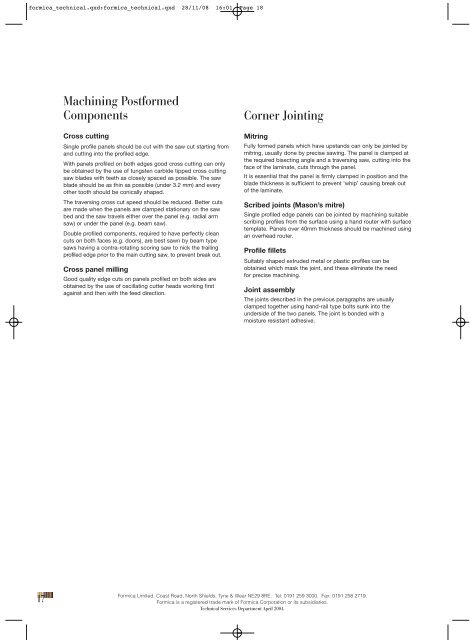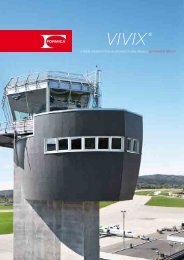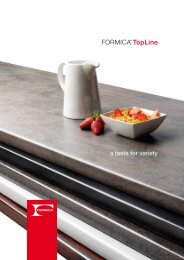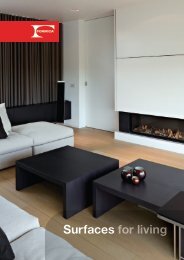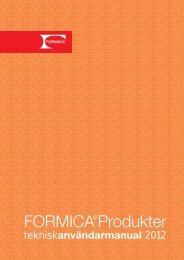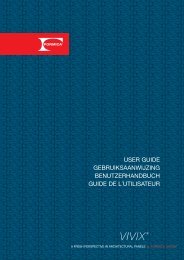Technical Information dispelling traditions - Formica
Technical Information dispelling traditions - Formica
Technical Information dispelling traditions - Formica
Create successful ePaper yourself
Turn your PDF publications into a flip-book with our unique Google optimized e-Paper software.
formica_technical.qxd:formica_technical.qxd 28/11/08 16:01 Page 18Machining PostformedComponentsCross cuttingSingle profile panels should be cut with the saw cut starting fromand cutting into the profiled edge.With panels profiled on both edges good cross cutting can onlybe obtained by the use of tungsten carbide tipped cross cuttingsaw blades with teeth as closely spaced as possible. The sawblade should be as thin as possible (under 3.2 mm) and everyother tooth should be conically shaped.The traversing cross cut speed should be reduced. Better cutsare made when the panels are clamped stationary on the sawbed and the saw travels either over the panel (e.g. radial armsaw) or under the panel (e.g. beam saw).Double profiled components, required to have perfectly cleancuts on both faces (e.g. doors), are best sawn by beam typesaws having a contra-rotating scoring saw to nick the trailingprofiled edge prior to the main cutting saw, to prevent break out.Cross panel millingGood quality edge cuts on panels profiled on both sides areobtained by the use of oscillating cutter heads working firstagainst and then with the feed direction.Corner JointingMitringFully formed panels which have upstands can only be jointed bymitring, usually done by precise sawing. The panel is clamped atthe required bisecting angle and a traversing saw, cutting into theface of the laminate, cuts through the panel.It is essential that the panel is firmly clamped in position and theblade thickness is sufficient to prevent ‘whip’ causing break outof the laminate.Scribed joints (Mason’s mitre)Single profiled edge panels can be jointed by machining suitablescribing profiles from the surface using a hand router with surfacetemplate. Panels over 40mm thickness should be machined usingan overhead router.Profile filletsSuitably shaped extruded metal or plastic profiles can beobtained which mask the joint, and these eliminate the needfor precise machining.Joint assemblyThe joints described in the previous paragraphs are usuallyclamped together using hand-rail type bolts sunk into theunderside of the two panels. The joint is bonded with amoisture resistant adhesive.17<strong>Formica</strong> Limited, Coast Road, North Shields, Tyne & Wear NE29 8RE. Tel: 0191 259 3000. Fax: 0191 258 2719.<strong>Formica</strong> is a registered trade mark of <strong>Formica</strong> Corporation or its subsidiaries.<strong>Technical</strong> Services Department April 2004.


